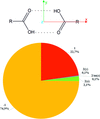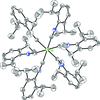issue contents
September 2019 issue

Cover illustration: The culprit is the ![[sigma]](/logos/entities/sigma_rmgif.gif) -hole: short I
-hole: short I N halogen bonds do not necessarily come with high electron density in their (3,-1) critical point. The I-C geometry and Raman spectroscopy complement information from electron density. See Wang, George, Potts, Kremer, Dronskowski & Englert [Acta Cryst. (2019), C75, 1190-1201].
N halogen bonds do not necessarily come with high electron density in their (3,-1) critical point. The I-C geometry and Raman spectroscopy complement information from electron density. See Wang, George, Potts, Kremer, Dronskowski & Englert [Acta Cryst. (2019), C75, 1190-1201].
scientific commentaries
Free 

There is an urgent need to improve our charge–density modelling capabilities for heavy atoms. A recent article opens up new opportunities in the charge–density and crystal engineering fields and in the overlap region between these fields.
feature articles
Download citation


Download citation


Open  access
access
 access
accessThe culprit is the σ-hole: short I⋯N halogen bonds do not necessarily come with high electron density in their (3,−1) critical point. The I—C geometry and Raman spectroscopy complement information from electron density.
CCDC reference: 1946856
research papers
Download citation


Download citation


The crystal structure of a new quantum memory-storage material, scandium yttrium oxyorthosilicate, was analyzed using single-crystal X-ray diffraction. A comparative analysis was made of the polyhedral distortion parameters and distribution features of the cations in the RE lattice sites in the mixed silicates RE12–xRE2xSiO5 (RE = Sc, Y, Lu or Tm).
CCDC reference: 1942657
Download citation


Download citation


Tetrahydrotetrazoles are rare five-membered ring heterocycles containing four contiguous saturated N atoms. We have confirmed the assigned structure of a previously reported tetrahydrotetrazole via X-ray crystallography.
CCDC reference: 1941061
Download citation


Download citation


Phenytoin sodium crystallizes as a threefold modulated crystal structure that consists of a supercell made up of three close-to-identical repeat units.
CCDC reference: 1944183
Download citation


Download citation


A new mononuclear europium complex incorporating the (+)-di-p-toluoyl-D-tartaric acid (D-H2DTTA) ligand, [Eu(HDTTA)3(CH3OH)3]n, has been synthesized and characterized. Circular dichroism spectra confirmed the chirality. The complex exhibits the characteristic red emission bands associated with the Eu3+ ion (CIE 0.63, 0.32), with a reasonably long lifetime of 0.394 ms, indicating effective energy transfer from the ligand to the metal centre.
CCDC reference: 1943541
Download citation


Download citation


A cyclic carboxylic acid dimer with disordered O—( H)⋯(
H)⋯( H)—O hydrogen bonds is observed in the crystal structure of N-tosyl-L-proline benzene hemisolvate. An analysis of the Cambridge Structural Database revealed that only six crystal structures with a similarly disordered cyclic dimer have been recognized previously.
H)—O hydrogen bonds is observed in the crystal structure of N-tosyl-L-proline benzene hemisolvate. An analysis of the Cambridge Structural Database revealed that only six crystal structures with a similarly disordered cyclic dimer have been recognized previously.
CCDC reference: 1921956
Download citation


Download citation


A novel stibium phosphate, LiBa(SbO)2(PO4)3, featuring an [(SbO)2(PO4)3]∞ three-dimensional open framework, can be used as a luminescent host lattice and emits green light after doping with Tb3+ ions.
CCDC reference: 1909308
Download citation


Download citation


A sulfur coordination polymer constructed from Zn2+ ions and 5-methylsulfanyl-1,3,4-thiadiazole-2-thione possesses high thermal and chemical stability and a linear temperature dependence of the bandgap from room temperature to 270 °C. Further investigation revealed that the bandgap changes sharply in ammonia, but only fluctuates slightly in other solvents, indicating its promising application as a selective sensor.
CCDC reference: 1828049
Download citation


Download citation


A drug–drug anhydrous salt containing tolbutamide and metformin was created based on drug combinations for type 2 diabetes. Pharmaceutical property alterations were associated with the crystal packing features and potential hydrogen-bonding sites through observed changes in the crystal structures.
CCDC reference: 1911224
Download citation


Download citation


The crystal structures of low-valent niobium isocyanide complexes are reported. The reaction of Nb(mesitylene)2 with 2,6-dimethylphenyl isocyanide resulted in a coupling of four isocyanide ligands, two per Nb atom, to produce dimers of the general formula [Nb(CNR)n]2[μ-C4(NR)4] (n = 4, 5), where the bridging ligand is a nitrogen (NR) analog of the squarate dianion, (C4O4)2−. The reaction with the bulkier isocyanide ligand 2,6-diisopropylphenyl isocyanide resulted in Nb(CNR)6, a rare paramagnetic monomer of formally Nb0.
Download citation


Download citation


Open  access
access
 access
accessThe disordered crystal structure of triphenylmethanol features tetrahedral chiral clusters formed through weak hydrogen bonds, leading to the formation of three-dimensional supramolecular motifs having left or right handedness.
Download citation


Download citation


A new phenylborate derivative of a Schiff base bridged phenolic diphenylamine antioxidant was prepared by a facile synthesis method and characterized by single-crystal X-ray diffraction. Thermogravimetric analysis and antioxidant activity in vegetable-based lubricant oil were studied.
CCDC reference: 1946858
Download citation


Download citation


A new lanthanum coordination polymer was prepared by employing a semi-rigid multidentate carboxylic acid ligand. It possesses (3,6)-connected two-dimensional kgd topology sheets consistsing of secondary building units of La2 clusters and 4,4′,4′′-{[(2,4,6-trimethylbenzene-1,3,5-triyl)tris(methylene)]tris(oxy)}tribenzoate ligands, which further stack into three-dimensional supramolecular networks through π–π interactions.
CCDC reference: 1946722
Download citation


Download citation


Three new ZnII CPs from 1D→3D with unique highly connected topologies were obtained by regulation of the flexible –CH2–O– linker of the 5-(4-carboxybenzyloxy)isophthalic acid ligand and subtle changes of the solvent, pH and auxiliary ligands. One complex shows high selectivity and sensitivity for detecting hexavalent chromate anions in aqueous solution, with a very low limit of detection of 0.434 µM for the Cr2O72− ion.
Download citation


Download citation


The structures of a new hybrid terpyridine–pyrazine ligand, 4′-[4-(pyrazin-2-yl)phenyl]-4,2′:6′,4′′-terpyridine (L2), and its one-dimensional coordination polymer, [Zn(acac)2(L2)]n (acac is acetylacetonate), are reported. A complete picture of the intermolecular interaction landscape revealed some subtle details, for example, that some weak (at first sight negligible) C—H⋯N interactions in the structure of free L2 play a relevant role in the crystal stabilization.
Download citation


Download citation


The crystal structures of SeP(o-tol)R2, where R is phenyl or cyclohexyl and o-tol is ortho-tolyl, are discussed, and their electronic and steric properties evaluated using various methods.
Download citation


Download citation


Through systematic variation of the heteroatom and position of the carboxyl group on 1,3-azolecarboxylic acids, their influence on supramolecular assembly is presented through nonbonding interactions and Hirshfeld surface analysis.


 journal menu
journal menu



































